Little Threads of Infinity
Sometimes, writing can feel like tugging at little threads of infinity. This is a simile suggested by the jacket I’m wearing today. It’s a beloved linen number of some ten summers, as a result of which the jacket is now unravelling along a number of seams. It has reached the stage where it makes my dry cleaner suck in his breath so much, I wonder if there’s a point where the sound of reluctance ends and asthma begins.
I have the same fear of an infinite unravelling whenever I sit down to write. There’s a point where the mind has no reason to stop dwelling on even the tiniest detail – one thinks of the Woolf story ‘The Mark on the Wall’. Everything is interesting, really.
But the problem with this is that I have a backlog of events from the last few weeks, which really should be at least declared, if only to paint in the parameters of my funny little life. This week’s selection of diary entries, and the next one, will therefore be more of a mopping-up. The temptation to tug on The Threads of Fact until they become The Unravelled Garments of Reflection will just have to be resisted.
***
Tuesday 4th May 2016. To the Cartoon Museum in Bloomsbury. A small gallery that nevertheless crams in two superb exhibitions: a major one about ‘The Great British Graphic Novel’, and a smaller one upstairs about the Doctor Who Target novelisations, which came out regularly in the 70s and 80s. Virtually every Doctor Who adventure was turned into one of these little books. I remember them well as a child. It was the era just before TV shows were available to buy on home video (long before DVDs). To revisit a favourite story, the fans had to read prose fiction. How strange now to think of novels as catch-up TV.
Each Target paperback had a specially commissioned cover rendered as a painting (hence the exhibition), branding the books more as imaginative explorations in their own right, rather than disposable cash-ins. They also encouraged a feeling of community, which is what merchandise and events like Comic-Con should always do. Join our club.
***
Thursday 5th May 2016. In the TLS I read a review by Tom Lean of Electronic Dreams, a book about 1980s computer games. One game, Deus Ex Machina, apparently featured a segment ‘in which the player has to guide a sperm to an egg in order to fertilize it. The astronomer Patrick Moore had been invited to voice the semen; he consulted his mother and, on her advice, declined.’
***
Sunday 8th May 2016. Afternoon: To a marquee in St James’s Square, for one of the Words in the Square events. This is a miniature literary festival, held by the London Library to mark its 175th anniversary. I attend ‘Desert Island Books’, a group discussion about favourite reads. Six authors sit on a stage and explain their choices in categories such as ‘Childhood Favourite’, ‘Biggest Influence’, ‘Guilty Pleasure’, ‘Tarnished Favourite’, and ‘Recent Favourite’. The authors are Philippa Gregory, Deborah Levy, John O’Farrell, Sara Wheeler, Nikesh Shukla and Ned Beauman. A gender note: all three men try to make the audience laugh, while the three women are more serious and wistful about the pleasures of reading. Though that’s a kind of playing to the crowd too.
Ned B’s ‘Guilty Pleasure’ is to go on Amazon and use the ‘Look Inside’ function to read the bits in crime thrillers where the killer reveals his motive. Nikesh S’s ‘Tarnished Favourite’ is a poetry anthology he contributed to in his teens. His initial excitement at having his dream realised was soon doused; the book turned out to be a scam by a vanity press.
Evening: To the Constitution in Camden for Debbie Smith’s Nitty Gritty club night. It’s such a sunny day that I walk all the way from St James’s, via the canal. At the club I meet the singer from the band Bete Noire, who I’m reliably informed have been making waves with their song, ‘Piss On Putin’.
***
 Saturday 29th May 2016. Mum in London for the day. We visit the British Library’s big summer exhibition, Shakespeare in Ten Acts. As usual with the BL, it’s a rich mix of the familiar (lots of rare books, a couple of First Folios present and correct), the educational (in-depth histories of early female and black actors) and the unexpected. In the latter case I’m fascinated with the details of the first overseas production, an amateur Hamlet on board a ship off the coast of Sierra Leone, as early as 1607. Shakespeare was still alive.
Also learned: King Lear was performed in a sanitised version for 150 years. This Restoration rewrite had a happy ending and omitted the character of the Fool entirely. When the full Shakespearean Lear was revived in the 1830s, the first actor to play the Fool was a woman, Priscilla Horton.
For me, the highlight is a whole room dedicated to Peter Brook’s 1970 production of A Midsummer’s Night Dream. This was the radically minimalist version, staged against plain white walls, with brightly coloured costumes, trapezes and stilts. In the exhibition, all the rooms are dark except for this one, a witty recreation of Brook’s clean white box. There’s even a trapeze one can sit on, albeit firmly anchored.
Lunch at Albertini in Chalton Street, followed by a walk around Camley Street Natural Park and a quick visit to the House of Illustration. Three small exhibitions in the latter: 1920s Soviet children’s books (when animal tales were suppressed as bourgeois constructs), a permanent Quentin Blake gallery, and a display of Japanese girls’ Shojo manga comics. Am intrigued about Keiko Takemiya, who is thought to have pioneered the yaoi genre: comics about gay male love, made by women for girls.
It’s a sunny day, and we have drinks outside in Granary Square (buying them at the trendy Granary Store bar). The area is still being finished, but it’s already King’s Cross’s answer to the South Bank, the canal standing in for the Thames. As with the Royal Festival Hall, hordes of people now descend here at the weekend, and seem to just sit around all day. Alcohol on concrete, bridges over water, art galleries, and the inevitable small children playing in fountains, the kind made up of jets of water springing up from the pavement.
In fact, the Granary Square fountains seem to be more artily-minded than the South Bank ones, perhaps because St Martin’s is next door. The jets switch constantly between different patterns of varying rows and heights. On the South Bank, the jets just rise up and go down. Either way, the children seem happy. Or at least, busy. Which with children, unlike adults, is the same thing.
Tags:
bete noire,
British Library,
cartoon museum,
doctor who,
house of illustration,
king's cross,
mopping up,
nitty gritty,
shakespeare,
target books,
The London Library
The Artist Known As…
Tuesday 17 May 2016. To Vout-o-Reenee’s to take a photo. It’s for my entry to a Birkbeck competition, which is asking for photos on the theme of ‘London Relocated’. An idea occurred to me, so I thought I’d give it a go. I thought about the way the Vout’s club is effectively the spirit of bohemian Soho relocated, in this case a few miles east in Tower Hill. Tonight I get Sophie Parkin to pose at the bar for my hopeful little image, alongside her book on the deceased Soho club, the Colony Room. I also get my own membership card of the Colony into the shot, visible on the counter of the Vout’s bar.
Sophie tells me about the charity Little Paper Slipper, which is having a major event at Vout’s in June. This is a charity that organises therapeutic art workshops, for women affected by domestic abuse. The end result is a series of exhibitions of the eponymous slippers, each one personalised by the woman who made it. There’s about 150 of them now.  The event at Vout’s is going to be a fundraising auction, featuring shoes specially made for the charity by a group of artists, including Gavin Turk, Molly Parkin, and John Claridge.
I’m happy to help publicise the event. There’s further details at Facebook here.
There’s some fascinating photos of the workshop slippers at the charity website:Â www.littlepaperslipper.com/slippers.html
***
Wednesday 18 May 2016. Evening: my debut as a conceptual artist. I am given a sticker for my lapel which says: ‘Dickon Edwards – Artist’. So it must be true.
The venue is Birkbeck’s School of Arts, on the east side of Gordon Square, once home to Virginia Woolf. This week is Birkbeck’s annual Arts Week, a series of free talks and events that are open to the public. Over the cast iron railings at the main entrance are the words ‘ARTS WEEK’ rendered as huge, colourful knitted letters. I discover that this display is not, as I’d hoped, the product of an MA course in Comparative Knitting, but the handiwork of two knitting-loving administrators, Claire Adams and Catherine Catrix.
Given the building’s history, I wonder what would have happened if those fateful railings in Mrs Dalloway had been similarly wool-clad. Septimus Smith might have ended the novel in better shape. Another thought is The Muppets’ Mrs Dalloway. Starring Miss Piggy as Clarissa: ‘Moi will buy the flowers myself!’
Inside, Room 112 hosts The Contemporary: An Exhibition. This is a ‘pop-up’ show by four students of the MA Contemporary Literature and Culture course, and addresses the question: what is ‘the contemporary’? The contributors are Kathryn Butterworth (in partnership with James Watkinson), Jassey Parmar, Dylan Williams, and myself. The event is the idea of the main course tutor, Grace Halden, who thought it would be good to have the MA represented during Arts Week.
Kathryn and James’s display is a multimedia look at technology and literature: there’s large boards covered in texts, computer diagrams, a model of DNA code, and laptops playing audio and video content. Jassey’s exhibit is a series of photographs of London shop fronts, which blend different cultures and brands in unexpected ways. Twice during the evening, Dylan performs a selection of his own poetry. And I’ve contributed a social media installation titled Is It Just Me?
I had the idea some years ago. It was one of those ideas that don’t go away. So I thought I’d either put it in a story, or just keep it in reserve, in case someone asked me to contribute to an exhibition.
So one day someone did, and here I am. A debut artist.
At the event, I give out an A4 handout to explain my thinking behind the installation. I’ve uploaded it here as a PDF:
Is it Just Me – installation handout
I also leave out a sheet of my handwritten notes for the project. I like the juxtaposition of the shifting internet content on the screen, with the fixed artifact of my handwriting on paper. Private traces of the body, versus public traces of the mind.
The event turns out to be decently attended, with tutors stopping by to say kind things. It all seems to go okay, and there’s no technical hitches, thanks to the efficiency of Birkbeck’s staff. How wonderful it is to have an idea which involves cables and equipment, but not have to worry about the cables and equipment oneself.
Here’s some photos from the course’s Facebook page (most of them taken by Lee Smith, used with permission):
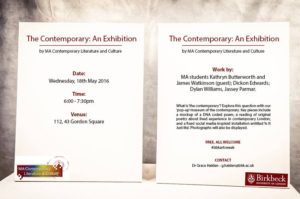
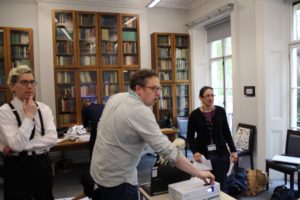
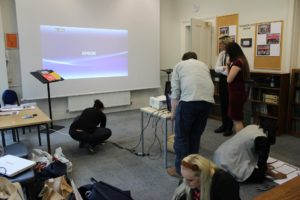
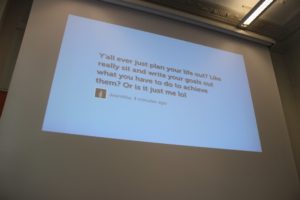
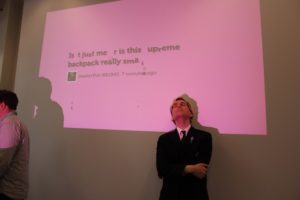
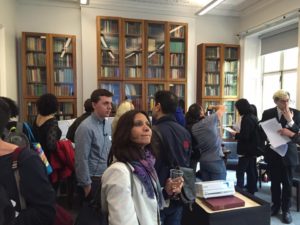
And here’s a link to the Facebook page for the MA in Contemporary Lit and Culture
***
Thursday 19th May 2016. Thinking more about Prince, and about camp uses of the colour purple, I’m reminded of this anecdote from Gary McMahon’s Camp in Literature (2006, p. 144):
‘Brigid Brophy notes that [Ronald] Firbank often wrote his tales in purple ink on blue postcards, surface and colour being everything to camp. Brophy reveals that she too wrote her critical biography of the man [Prancing Novelist, 1973] in purple ink. My working copy of Brophy’s book is on loan from Manchester University’s library. At this purple confession on page 173, a university student […] has written this response in the margin:
“Are you [Brophy] really as besotted as this? If so, we don’t want to know. At least maintain a pretence at objectivity, please.”
McMahon remarks that this student represents a certain academic sensibility ‘that is always going to be exasperated and offended by camp’.
Returning to Prince, I think of a friend’s anecdote along the same lines. When this friend was growing up in the 80s, some blokish gentleman known to them – a friend or possibly a dad – took one look at a Prince record sleeve and remarked, quite out of the blue, ‘I don’t care what he sounds like. I’m not listening to anyone who dresses like that.’
***
Friday 20th May 2016. I receive the grade for my second essay on the MA. Despite my struggles with it, I am very pleased indeed to get a 76 (a mark over 70 is a Distinction, the MA equivalent of a First). The first essay got a 73. It’s a nice boost to my confidence when I needed it most, wracked as I was with Difficult Second Term Syndrome.
For the rest of the summer, I have to get on with postgraduate-y things under my own steam, such as attending open lectures and pursuing my own research. But as far as the big assessments go, the pressure is off until the autumn.
Tags:
art,
birkbeck,
birkbeck arts week,
brigid brophy,
colony room,
little paper slipper,
Prince,
ronald firbank,
sophie parkin,
vout-o-reenee's
Diamonds and Beaus
Friday 13th May 2016. Early afternoon: I’m recognised in Jermyn Street by a gentleman who says he enjoys this diary. In fact, he crosses the street to tell me this, narrowly avoiding being run down. Surely no writer can ask for higher praise than this: a reader risking their own life to pass on a good review. Perhaps it should go on the back of a book. ‘I enjoyed Dickon Edwards so much, I was nearly hospitalised’.
He adds that he was disappointed I didn’t say more about the death of Prince, given what I’d said about Bowie a few months earlier. This is a perfectly good point.
I think one reason might be that, when I was growing up, I’d always regarded Prince as one of my brother Tom’s favourites; his territory more than mine. For some reason we divided up singers and bands between us, as if they were soft toy animals. I got to cuddle New Order, the Pixies and the Smiths, Tom had the Cult, the Beastie Boys, and Prince.
But if one loves good pop songs, and believes, as I do, that pop music is at its best when used as a platform for individuality, eccentricity, and indeed dandyism, obviously one has to admire Prince.
It’s all the more apt that this request took place on Jermyn Street. The street is something of a dandy Mecca, being home to some of London’s most stylish menswear shops, to the church of St James’s Piccadilly, where Sebastian Horsley had his funeral in a red squinned coffin, and to a statue to that most influential of London dandies, Beau Brummel. It is a statue close enough to the ground to be hugged, an act which dandyish American friends of mine make a point of doing whenever they visit.
A further coincidence is that I was on my way to the London Library, a block away in St James’s Square. After parting company with the reader, I remember that I’d once found a book on dandyism in the library, one which directly compared Prince with Beau Brummell. So today I go straight into the stacks and retrieve the book in question.
The book is called Rising Star: Dandyism, Gender and Performance in the Fin de Siècle, by Rhonda K. Garelick (Princeton, NJ: Princeton University Press, 1998). As part of a chapter on the legacy of dandyism, Garelick reprints a 1995 Esquire cover, on which Prince pulls a definite dandyish pose. It’s from his Artist Formerly Known As phase, just after his hit, ‘The Most Beautiful Girl In The World’. His hair at this point is short, dark, combed and straightened, with a touch of the silkily feminine (even a Hugh Grant-ish schoolboy floppiness). He has a thin pencil beard that seems an extension of his cheekbones, and wears a slim pinstripe suit, buttoned down, over a white shirt with big cuffs. He sports a dark tie (collar button undone), fingers covered in rings, and leans against a silver cane.
According to Garelick, Prince’s image at this point follows in the classic nineteenth-century dandy traits. Prince ‘borrows unmistakably from the likes of Beau Brummell, Baudelaire and Jean Lorrain’. The main criteria are his aloofness, his air of contempt for convention, and his highly stylized persona. On top of that, his 1990s adoption of an unpronounceable symbol allies him with Barbey d’Aurevilly’s idea of the dandy life: one of pure surface and symbol, an influence beyond language: the dandy is ‘that which can hardly be recounted’. Certainly, changing one’s name to an actual symbol takes that aspect of dandyism to the limit. Though I’d say Prince had already put his stamp on language by that point, given his love of turning words into single letters or numbers, as in ‘I Would Die 4 U’.
The gendered aspects of Prince’s dandyism were equally fascinating. Granted, it may not have been original for a male, black, American performer to play with femininity in the rock and pop field; one thinks of Little Richard and Rick James. But Prince used his influences in order to do as Bowie did: make something new. He especially intensified the androgynous aspects of his imagery, imbuing them with that most deviant of colours – purple.
I think of that campest of pre-war dandy writers, Ronald Firbank, and his love of writing with purple ink. I also think of Brigid Brophy taking this detail of Firbank’s so much to heart, she apparently switched to using purple ink for the longhand manuscript of Prancing Novelist, her 1973 study of Firbank. The Brophy book is 600 pages long. That’s a lot of purple.
Through these deviant codes, Prince’s dandyism became an outrageous queering of heterosexuality – a machismo-troubling version of Camp Rock which he shared with such figures as Marc Bolan, Tiny Tim and Russell Brand (who isn’t even a musician, but he hasn’t let that stop him).
Garelick’s book also compares Prince’s use of female dancers and co-singers with names as Vanity, Apollonia, and Mayte, as echoing 1890s Decadent ‘tableaux’, such as ‘Aubrey Beardsley’s Salome drawings of androgynous, erotic, and nearly twin creatures’. Though in Prince’s case, says Garelick, the women were not so much twins as shadows in his wake, a ‘merging of the dandy and the danseuse‘.
Certainly, any woman appearing with Prince had to become remade in his image. I never saw Prince in concert, but I was interested enough to catch his 1987 concert film Sign o’ the Times, when it hit British cinemas. For the song ‘U Got The Look’, the female role was filled by the Scottish singer Sheena Easton, who’d already had a successful career in her own right. For ‘U Got The Look’, though, she became well and truly Prince-i-fied. From her singing to her clothes to her poses, she was not so much a guest vocalist as just another interchangeable cog in the man’s machine. When in Purple Rome, you do as the Purple Roman does.
More recently, I thought of Prince when I heard the song ‘Quicksand’ by La Roux, aka Elly Jackson, a young singer who might herself be described as a dandy (the National Portrait Gallery’s shop currently has her on a postcard, wearing a very Bowie-esque mustard yellow suit). Musically, ‘Quicksand’ is clearly influenced by ‘When Doves Cry’, from the chords to the clipped 80s synths. But Ms Jackson’s singing is a very Prince-like style too: shifting across the genders from high feminine falsetto to low, growing boyish swagger. For me, that’s when art is at its best: when there’s a breaking out of prescribed roles, and the same trappings of said roles are re-used on the artist’s own terms, to communicate their individualism. And that’s also a definition of dandyism, in my book.
***
Evening: to the ICA to see Mustang, a Turkish film, set in the present day, about five teenage orphan sisters living in what seems like an idyllic picturesque setting: a hillside village near the Black Sea coast. Their mildly rebellious behaviour during the school holidays, however, sees them dramatically punished by their guardians – first with imprisonment in their own home, complete with bars on the windows, and then into forced marriage to equally reluctant young men. The film’s sensualised, slightly surreal atmosphere accentuates the idea of a close-knit group of girls disappearing into a world of their own, thus placing the film in the same tradition as Picnic at Hanging Rock, The Virgin Suicides, and last year’s The Falling.
With the added dimension of the conservative Turkish setting, though, Mustang has more complex questions about the role of arranged marriage in a changing world. The girls’ captor, their grandmother, is no fairy tale tyrant; she merely believes that, because she herself was married off straight after puberty, that’s the way it should be. Indeed, for one of the sisters, her marriage to the boy she was already seeing is shown as a good thing, if a hasty one. For the others, though, freedom comes in the form of escape to the big city – Istanbul – and to the parent they really want: a beloved schoolteacher. The real asset of the film, though, is the utterly naturalistic and convincing performances, particularly by the youngest sister.
Tags:
brigid brophy,
Dandyism,
ICA,
jermyn street,
la roux,
Mustang,
Prince,
ronald firbank,
The London Library
Letters As Pandas
Monday 25th April 2016. Working on the second draft of the MA essay. It’s 3000 words over the limit, so most of the work is working out which bits to cut. Some are obvious – simply any sections that I feel less confident about. Others fall into the category of ‘Fascinating And Original Insights That I Feel The World Will Benefit From, But Which Aren’t Relevant To The Current Matter At Hand’.
***
Reading Hollinghurst’s Swimming-Pool Library, I find a line in which a character refers to Brideshead Revisited as ‘that deplorable novel’. All the more amusing, given that the AH’s later works The Line of Beauty and The Stranger’s Child are often compared to Brideshead.  Today, Sebastian Flyte and his teddy bear seem more invulnerable than ever: there’s a new stage production of Brideshead doing the media rounds.
***
Tuesday 26th April 2016. To Senate House Library, for one of the many Shakespeare exhibitions for the 400th anniversary of his death. This is one is called Shakespeare: Metamorphosis. It presents a history of the Bard in print, via a ‘Seven Ages of Man’ theme. The last age, the decrepit ‘sans teeth, sans eyes’ one, is used for the digital era, now that every play is easily accessible online. Thus the great man is now ‘sans binding, sans pages’. Some irony, though, as I’m writing this up from the exhibition leaflet.
Among the exhibits is a copy of Golding’s sixteenth-century translation of Ovid’s Metamorphoses, an edition similar to the one that inspired Shakespeare. The title page says: ‘Tr. Arthur Golding Gentleman. A work very pleasant and delectable.‘ I’m also intrigued by some pristine copies of a 1940s series aimed at schoolchildren, The Satchel Shakespeare. Each play was published as a slim, dark green paperback, light yet somehow sturdy enough to survive a child’s satchel.
As is increasingly the case with historical exhibitions, displays of personal letters tend to be a highlight. Given that the medium of letters is more of an endangered species than the medium of books, even a copy of the First Folio can seem less exotic than letters from a few decades ago.  One only has to point to the success of the Letters of Note books and the Letters Live events to show the changing role of letters; from commonplace pursuit to otherworldly public spectacle. If curators are the zoo keepers of culture, letters are the new pandas.
Consequently, my favourite item in this Shakespeare show is a 1957 correspondence between the University of London’s JH Pafford, and the German scholar Richard Flutter. At the time, Pafford was editing the Arden Shakespeare edition of The Winter’s Tale. Flutter had just published a letter in which he argued that Shakespeare only wrote a fraction of the play. Pafford duly wrote to Flutter asking him to explain this theory in more detail, though he adds that he’s already firmly convinced the play is fully Shakespeare’s. In the reply, also on display, Flutter replies, quite reasonably: ‘Why do you want me to mix a cocktail for you when you are firmly determined not to drink it?‘
***
Saturday 30th April 2016. The essay seems to be taking forever. I’m finally on the third draft, working most days in Birkbeck Library, in Torrington Square. Today I don’t finish till half past ten at night. As I walk out, thinking this is late enough, I notice that dozens of students are still hard at it. The library doesn’t close until quarter to midnight.
***
Sunday 1st May 2016. Weather getting warmer at last. Speak to Mum on the phone in the morning. Then off to the library again. Fourth draft of the essay.
***
Bank Holiday Monday, 2nd May 2016. Essay deadline at noon, so I’m up early to revise the fifth draft in pen. By the time I finish, it’s getting on for eleven. I still have to type up the corrections. So I hit the PCs in Birkbeck Library and frantically type away, barely taking a breath. I upload the finished version to the college website just in time, with about a minute to spare. It’s like a scene from a bad thriller.
All done now. The essay is by far the one I’ve worked the hardest on, at least to date. I only hope the effort comes across. Still, I’m at least confident that it’s full of uncommon and useful insights – the silver lining of a mind stuck in Lateral Mode.
There’s a phrase used to describe Peter Cook which I feel sums up the sentiment: ‘at a slight angle to the universe’. To be worried about being the wrong kind of ‘different’ in some respects, yet hoping to be the right kind of ‘different’ in others, such as in one’s writing. That’s the hope, anyway.
***
Evening: to the Odeon Leicester Square, in one of the smaller screens reserved for the less recent films. I see Star Wars: The Force Awakens, nearly five months after it opens. I’m making good on my (slightly silly) promise, made as a reaction to the aggressive, ubiquitous marketing of the film last December. I resolved to only go and see it when it had been reduced to one screen in central London. Which is now the case.
Tonight’s screening is still fairly well-attended, with a mixture of ordinary-looking people and tourists, and of all ages too. No rabid geeks seeing it for the umpteenth time – at least not visibly.
Then again, Star Wars fans come in all forms. A while ago I listened to an edition of A Point of View on BBC Radio 4. Helen Macdonald, the author of H is for Hawk, who is the same generation as me, talked about going back to see The Force Awakens six times. And this was back in February.
Ms Macdonald explained that for her, the new film represented a reassessment of her late 70s childhood, filtered through more up-to-date concerns, like a moving away from older stereotypes of race and gender. She also suggested that it acknowledged the rise of fan fiction, the genre where admirers of a fictional world remodel it for themselves and write their own amateur stories – often improving on it. They are like the heroine Rey in the film – ‘scavengers’ of the old, seizing on the elements which still work, and giving them new purpose. I’d say that Benedict Cumberbatch’s Sherlock does the same. What might look like indulgent nostalgia at first, becomes an expression of human continuity.
Actually, the original Star Wars was itself a kind of 1970s fan fiction, what with George Lucas drawing on the campy Flash Gordon serials of his own youth, and bringing in Joseph Campbell’s theories of an even older continuity – classical mythology. Harry Potter has similar aspects: the orphan hero, the boarding school, touches of E Nesbit and CS Lewis – but with the less troubling and politically incorrect bits updated. A sense of exploring within a tradition, though, rather than mere box ticking.
The first half hour of the new Star Wars has some stunning imagery, particularly the isolated use of blood stains on a white Stormtrooper’s helmet – the first sign that the bad guys might be complicated humans too. Adam Driver steals the show: a walking, ready-made metaphor for all kinds of masculinity. From the way little boys can be inexplicably drawn to violence (I think of the Saki tale, ‘The Toys of Peace’), to the sons who join Islamic State, to the long-haired villains in manga comics.
I’m still not wholly converted to the cause, though: for all the reports of the director, Mr Abrams, making the film look more physical and haptic than the wafer-thin prequels, there’s still some pedestrian CGI monsters with tentacles halfway through. I miss the fabulous rubbery tentacles of the 1977 Trash Compactor Monster. Perhaps that’s where the line is drawn these days. The making of rubber tentacles has become a lost art. As with ‘craft beer’, perhaps there needs to be a revival in ‘craft tentacles’.
***
Wednesday 4th May 2016. Evening: to the Dalston Rio with Shanthi S and Rosie. We see the biopic of Miles Davis, Miles Ahead. Don Cheadle growls his way quite convincingly through the life of the volatile trumpeter. The film constantly flashes back and forth in time, often quite randomly. So the audience is grateful for Mr Cheadle’s vivid changes in appearance: neat short hair and shirt sleeves for the classic phase in the 50s and 60s, then afro and loud shirts for the sadder, reclusive Davis of the late 70s. Ewan McGregor turns up as a Rolling Stone reporter, looking like he’s auditioning for the next Kurt Cobain biopic.
It’s the later showing, at 9.20pm, and we down a few drinks at the Arcola Theatre bar first. Drinks and lateness turn out to be perfect companions for Miles Ahead, just as they were for Victoria the other week. Both films are steeped in an atmosphere of booze, late nights and city bars. The main difference with Miles Ahead, though, is that it’s a period piece. So there’s a huge amount of smoking inside the bars, too. Ashtrays sit on the tops of pianos in darkened clubs, each one duly cradling a lit cigarette. The smoke snakes its way up and around the scene, as much part of the visuals as the actors. It’s an unthinkable sight for a city bar now. It’s How We Used To Smoke.
Tags:
birkbeck,
essay writing,
miles ahead,
senate house,
shakespeare,
star wars











